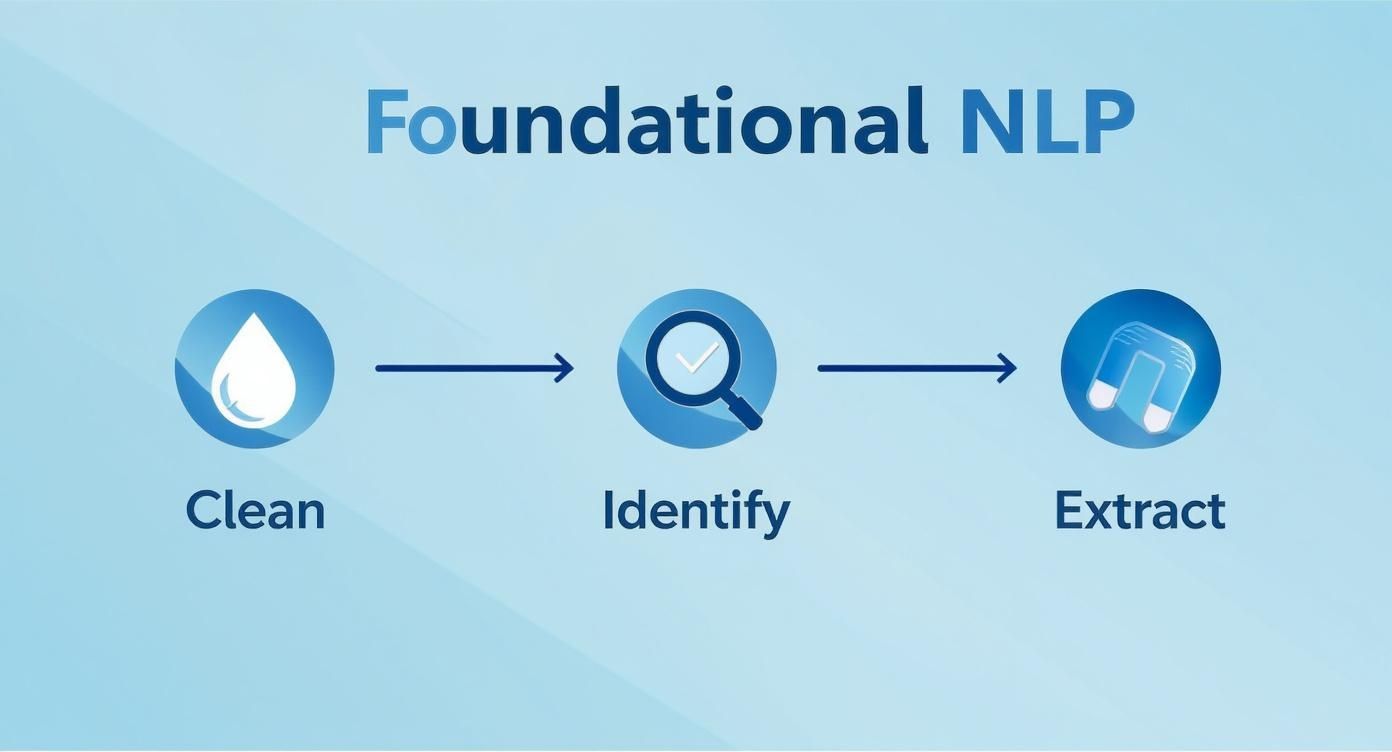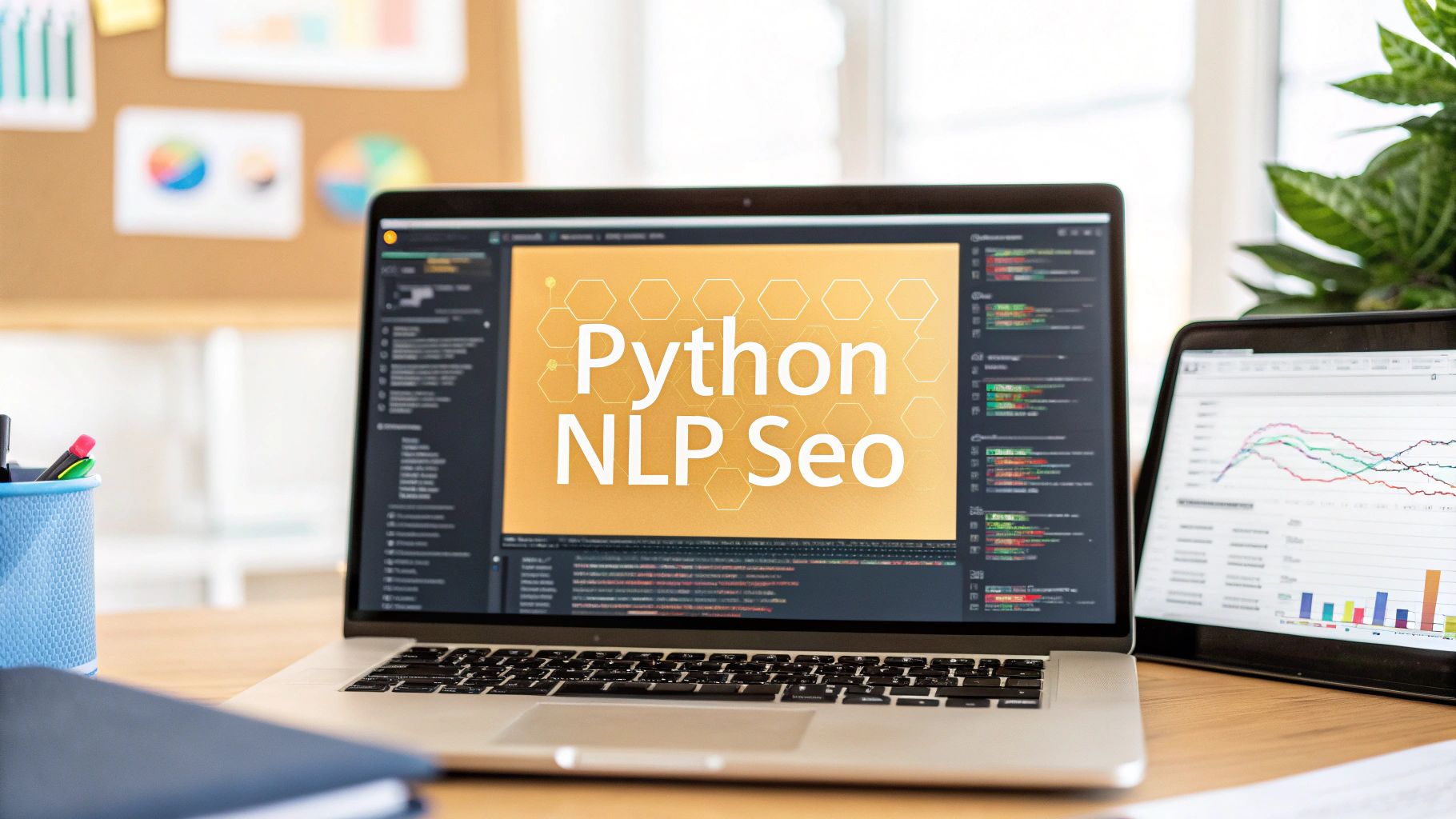Using Python for NLP and semantic SEO is all about getting under the hood of your content. Instead of just chasing keywords, you're using programming to figure out what your content actually means and how it lines up with what people are searching for.
We'll be using some seriously powerful libraries like spaCy, NLTK, and Hugging Face Transformers to do things like topic modeling, entity recognition, and semantic similarity analysis. This isn't just about data; it's about turning raw search insights into a real competitive advantage.
Why Python Is Your New SEO Superpower

The days of winning at SEO by just stuffing pages with keywords are long gone. Thank goodness.
Today, search engines like Google use incredibly sophisticated models to understand the meaning and intent behind a search, not just the words typed into the box. This massive shift toward semantic search means our SEO strategies have to evolve, too.
Python, paired with Natural Language Processing (NLP), gives you the perfect toolkit for this new reality. It lets you move past manual, gut-feeling analysis and start dissecting language at a massive scale. Instead of guessing what users want, you can programmatically analyze the top-ranking content, pinpoint crucial sub-topics, and map out user intent with data-driven precision. This is the heart of modern, AI-powered SEO.
Bridging Code and Content Strategy
The real magic happens when you use Python to automate the kind of deep analysis that would be flat-out impossible to do by hand. This technical approach feeds directly into your creative and strategic decisions, building a solid bridge between data science and content marketing.
With just a few lines of code, you can start doing some powerful stuff:
- Systematically analyze the SERPs: Scrape the top 20 results for a target query and extract the core themes, entities, and concepts that Google is clearly rewarding.
- Find glaring content gaps: Pit your content against the top performers to find semantic differences and uncover entire sub-topics you’ve completely missed.
- Build real topical authority: Use topic modeling to generate data-backed content clusters that cover a subject so comprehensively that you become the go-to resource.
- Nail user intent: Automatically classify query types to make sure your content gives searchers exactly what they're trying to accomplish.
This focus on semantic relevance isn't just theoretical. We've seen that websites using these strategies get twice as many featured snippet placements—a huge advantage in today's crowded search results.
To give you a quick lay of the land, here are the core libraries we'll be touching on and what they're good for in the world of semantic SEO.
Core Python Libraries for Semantic SEO Tasks
This table is a quick reference for the essential Python libraries we'll cover and their primary jobs in our SEO workflows.
| Python Library | Primary NLP Function | Key SEO Application |
|---|---|---|
| NLTK | Tokenization, stemming, lemmatization | Preprocessing text from SERPs and competitor content. |
| spaCy | Entity recognition, POS tagging | Identifying key people, places, and brands to optimize for. |
| Gensim | Topic modeling (LDA) | Discovering hidden sub-topics to build content clusters. |
| Transformers | Access to pre-trained models (BERT) | Generating text embeddings for semantic similarity tasks. |
| Scikit-learn | ML models, text vectorization (TF-IDF) | Clustering keywords, classifying user intent. |
| Beautiful Soup | HTML parsing and web scraping | Extracting text content from competitor web pages. |
Each of these tools has a specific role to play, and learning how to combine them is what unlocks some seriously advanced SEO tactics.
The Real Impact on Your Rankings
At the end of the day, semantic SEO is about improving your rankings by obsessing over user intent. It works. In fact, Google now rewrites over 60% of title tags to better match what it believes a searcher is actually looking for. That stat alone shows that context and relevance have crushed exact keyword matching.
To really get a handle on how much AI is changing the game, you should check out this comprehensive guide to LLM SEO and AI Search Ranking.
By adopting these Python-driven techniques, you stop optimizing for a machine and start creating genuinely better, more helpful content. You're building something that resonates with your audience and cements your authority. It’s this data-first approach that separates good content from the content that absolutely dominates the search results.
Setting Up Your Python SEO Environment

Before we start analyzing SERPs and clustering keywords, we need to get our workspace in order. A clean, stable Python environment is the foundation for any serious NLP project—it keeps your dependencies from turning into a tangled mess and makes your work repeatable. Getting this right from the start will save you a world of headaches later on.
First things first, you'll need a modern version of Python. While most systems come with it pre-installed, you'll want to be on Python 3.8 or newer to use the latest libraries without a fuss. You can check what you're running by popping open a terminal and typing python --version.
Isolate Your Projects with Virtual Environments
With Python sorted, the single most important habit to build is using a virtual environment. Think of it as a clean, self-contained sandbox just for this SEO project. This simple practice prevents library versions from one project from clashing with another, a super common source of weird, hard-to-diagnose bugs.
Setting one up is a breeze on any OS.
- Navigate to your project folder in your terminal.
- Run this command:
python -m venv seo_env - Then, activate it. For macOS/Linux, it's
source seo_env/bin/activate. On Windows, you'll useseo_env\Scripts\activate.
You'll know it worked when you see (seo_env) at the start of your command prompt. From now on, any library you install will live neatly inside this little bubble.
A dedicated environment for each project is a non-negotiable best practice. It ensures your code will run consistently today, tomorrow, and a year from now, no matter what other Python work you do on your machine.
Installing the Essential NLP Libraries
Now that your environment is active, it's time to stock our toolkit. The libraries we're about to install are the workhorses for just about every task in this guide on how to use python for nlp and semantic seo. We'll grab them all using pip, Python's package manager.
You could install them one by one, but it's way faster to do it in a single shot. Run this command in your activated terminal:
pip install nltk spacy pandas scikit-learn transformers sentence-transformers beautifulsoup4
Here’s a quick rundown of what each one brings to the table:
- NLTK & spaCy: These are your foundational NLP toolkits. NLTK is a classic for basic text processing, while spaCy is a beast for production-level tasks like Named Entity Recognition, and it's incredibly fast.
- Pandas: The undisputed champion for wrangling data in Python. You'll be using this constantly to organize and clean the data you pull from SERPs.
- Scikit-learn: A powerhouse machine learning library that’s perfect for tasks like TF-IDF vectorization and topic clustering.
- Transformers & Sentence-Transformers: These libraries from Hugging Face unlock state-of-the-art models like BERT, which are essential for the more advanced semantic similarity and embedding tasks.
- Beautiful Soup: A simple but mighty library for parsing HTML. It makes pulling text content from messy web pages almost trivial.
There's one last piece. After installing spaCy, you need to download a language model. The small English model is a great place to start and is usually all you need for most SEO tasks.
python -m spacy download en_core_web_sm
And that's it—your environment is primed and ready. You've just built a robust, isolated setup specifically for SEO analysis. If you're thinking about how custom solutions like this can fit into your broader business strategy, exploring AI consulting services can help you map out a clear path forward.
Uncovering Insights with Foundational NLP
Alright, with your setup handled, it's time to get our hands dirty. This is where we bridge the gap between abstract SEO theory and practical, Python-driven action. We’re going to use a few foundational Natural Language Processing (NLP) techniques to turn all that messy text from SERPs and competitor articles into structured, usable insights.
Essentially, we're teaching Python to understand language the way an SEO expert needs it to.
First things first: every good analysis starts with cleaning the data. Web pages and search results are littered with "noise"—common words like "the," "is," and "in" that don't add much meaning. These are called stop-words, and getting rid of them lets us focus on the terms that actually define a topic. If you're new to this space, getting a handle on the basics of What Is Natural Language Processing will give you some helpful context for these core ideas.
From Sentences to Signals
After clearing out the noise, we move on to tokenization. It sounds technical, but it’s really just the process of breaking down sentences into individual words, or "tokens." Once we've isolated each word, we can start analyzing its frequency and importance. This is the first real step toward figuring out what a piece of content is truly about.
Imagine you're analyzing the top ten articles for "home office setup ideas." A simple Python script can pull the text, strip out the stop-words, and tokenize everything. What you're left with is a clean, meaningful list of terms from each competitor—pure gold for your content strategy.
Let's see how this works using spaCy, a seriously powerful and efficient NLP library for Python.
import spacy
Load the small English model
nlp = spacy.load("en_core_web_sm")
Example text from a competitor's article
text = "The best home office setup includes an ergonomic chair, a large monitor, and good lighting to improve productivity."
Process the text with spaCy
doc = nlp(text)
Create a list of tokens, excluding stop-words and punctuation
meaningful_tokens = [token.lemma_ for token in doc if not token.is_stop and not token.is_punct]
print(meaningful_tokens)
Output: ['good', 'home', 'office', 'setup', 'include', 'ergonomic', 'chair', 'large', 'monitor', 'good', 'lighting', 'improve', 'productivity']
Notice we're using .lemma_ in that snippet. That’s for lemmatization, which boils words down to their root form (like turning "includes" into "include"). This step is crucial because it groups variations of the same word together, giving us a much cleaner and more accurate dataset for analysis.
Identifying Important Terms with TF-IDF
So we have clean tokens. Now what? How do we figure out which ones actually matter most? A simple word count won't cut it, since common terms can skew the results. This is where Term Frequency-Inverse Document Frequency (TF-IDF) comes into play.
TF-IDF is a statistical measure that tells us how relevant a word is to a specific document within a whole collection of documents. It’s a bit of a balancing act between two key metrics:
- Term Frequency (TF): How often a word shows up in one document.
- Inverse Document Frequency (IDF): How rare or common that word is across all the documents.
A word gets a high TF-IDF score if it appears a lot in one article but not so much in the others. This flags it as a unique and important term for that specific page. When you run TF-IDF across all the top-ranking articles for a query, you get a data-backed list of the most important terms defining the topic landscape.
Extracting Key Entities for Deeper Optimization
Going beyond individual terms, modern semantic SEO is all about understanding entities—the real-world people, products, organizations, and locations mentioned in the text. The NLP technique for automatically finding and categorizing these is called Named Entity Recognition (NER).
Why is this such a game-changer for SEO? Because search engines like Google build their knowledge of the world around entities and the relationships between them. When you extract the entities from top-ranking content, you get a checklist of concepts you absolutely must cover to be seen as an authority on the topic.
Let’s say you run an NER model on your top three competitors for a target keyword. You might find they all mention specific brands like "Herman Miller" (an organization) or products like "Logitech MX Master." This isn't just a keyword—it's a critical entity. Mentioning it signals to Google that you have deep expertise, making it a clear, actionable step for your own content.
The use of Python for NLP has completely changed the keyword research game, especially for semantic SEO. In fact, by 2025, it's expected that around 86% of SEO professionals will have adopted AI tools—many of them Python-based—to sharpen their content strategies. These tools are built on the foundational techniques we've just covered: cleaning, tokenizing, and extracting. They are the bedrock of any serious effort to use Python for smarter, more effective SEO.
Building Content Clusters with Topic Modeling
If you want to truly dominate a topic, you have to think bigger than just optimizing one page for one keyword. Modern SEO is all about topical authority—showing Google you have deep, comprehensive expertise across an entire subject. This is exactly where Python comes in, letting you build out strategic content clusters based on hard data, not just guesswork.
Topic modeling is a type of unsupervised machine learning that sifts through a pile of documents and automatically finds the hidden themes, or "topics," that tie them all together. For an SEO, this is a total game-changer. You can run a topic model on the text from the top-ranking pages for a big, broad term and essentially reverse-engineer the subtopics Google already thinks are important.
Uncovering Hidden Themes with Latent Dirichlet Allocation
One of the most battle-tested algorithms for this job is Latent Dirichlet Allocation (LDA). The name sounds a bit intimidating, but the concept is actually pretty straightforward. LDA works on the assumption that every document is a mix of different topics, and every topic is made up of a collection of related words.
Let's say we analyze a bunch of articles ranking for "project management software." An LDA model might spit out clusters that look something like this:
- Topic 1 (Features): gantt, chart, task, timeline, dependency, kanban, board
- Topic 2 (Integrations): slack, google, drive, api, zapier, connect, import
- Topic 3 (Pricing): plan, user, price, tier, free, business, enterprise
These automatically generated groups give you a perfect blueprint for a pillar-and-cluster content model. Your main keyword ("project management software") becomes the pillar page, and each topic the model uncovers is a prime candidate for a detailed cluster article that links back to it. This is a core tactic when you're learning how to use python for nlp and semantic seo.
The Python Workflow for Topic Modeling
Getting these insights follows a repeatable process: you scrape the content, clean up the text, and then run the model. It all starts with gathering your raw material—the actual text from the top 10-20 search results—and then prepping it so the model can make sense of it.
The flow below gives you a high-level look at the foundational steps for any advanced NLP task, including the one we're running here.

As you can see, you always have to start with clean, structured data before you can start identifying patterns and pulling out meaning.
Once your text is prepped, you can use Python libraries like Gensim or scikit-learn to build and execute the LDA model. The output will be a list of topics, each defined by its most important keywords.
import gensim from gensim import corpora from gensim.models import LdaModel from sklearn.feature_extraction.text import CountVectorizer
Assume 'processed_docs' is your list of cleaned texts from SERPs
vectorizer = CountVectorizer(stop_words='english', max_features=1000) data_vectorized = vectorizer.fit_transform(processed_docs)
Create the term-document matrix and dictionary for Gensim
corpus = gensim.matutils.Sparse2Corpus(data_vectorized, documents_columns=False) id2word = dict((v, k) for k, v in vectorizer.vocabulary_.items())
Build the LDA model
num_topics = 5 lda_model = LdaModel(corpus=corpus, id2word=id2word, num_topics=num_topics, random_state=100, passes=10)
Print the topics
for idx, topic in lda_model.print_topics(-1): print(f"Topic: {idx} \nWords: {topic}\n")
This snippet hands you a data-backed view of the underlying themes that connect the pages already winning in the SERPs.
From Model Output to Content Strategy
The real magic isn't just running the code; it's in what you do with the results. That list of topic words from the LDA model is your new data-driven content plan. Here's how to put it into action:
- Map Out Your Cluster Content: Each topic cluster is the perfect foundation for a supporting blog post. This ensures every article you write directly addresses a subtopic that Google already associates with your main head term.
- Spot Obvious Content Gaps: Compare the topics your model found against your existing site content. Are there any themes you haven't touched on at all? That's your lowest-hanging fruit for creating new content that you know is relevant.
- Beef Up Your Pillar Page: Go back to your main pillar page and make sure it briefly touches on each of the topics you discovered. This builds semantic relevance and gives you the perfect spot to internally link out to your more in-depth cluster pages.
By using topic modeling, you’re not just creating content; you’re architecting an ecosystem of interconnected articles. This structure signals to search engines that your website is an authoritative resource, making it more likely to rank for a wide array of related long-tail queries.
This structured approach turns content planning from a purely creative exercise into a strategic, data-informed process. It makes sure every single piece of content serves a purpose within a larger topical framework, which maximizes its SEO impact and helps you build real authority that lasts.
Using Transformers for Advanced Semantic Analysis

While the classic techniques like TF-IDF are still useful, they're a bit old-school. They mostly just count words. To really get on the same page as modern search engines, you have to go deeper—into the world of meaning and context.
This is where Transformer models like BERT and its cousins completely change the game for semantic SEO.
Transformers don't just see words; they understand the intricate relationships between them. They get nuance. They can figure out that "bank" means two different things in "river bank" versus "investment bank." This is how you start to perform the kind of sophisticated analysis that mirrors what Google is doing on their end.
The secret sauce here is something called semantic embeddings. Think of them as numerical fingerprints for text. They are long lists of numbers—called vectors—that capture the contextual meaning of a word, sentence, or even a whole document. The magic is that texts with similar meanings will have vectors that are mathematically close to each other. This simple but powerful concept unlocks a whole new level of SEO strategy.
Turning Text into Meaningful Vectors
Getting your hands on these advanced models isn't as intimidating as it sounds, largely thanks to the Hugging Face ecosystem. Their sentence-transformers library, in particular, makes creating high-quality embeddings ridiculously easy. You can turn any piece of text into a rich, meaningful vector with just a handful of Python code.
This process is the bedrock for pretty much all the advanced semantic tricks we're about to cover. The rise of LLMs has cemented Python's role as the language for this work. In 2025, with models like OpenAI's GPT series and Google's Gemini at the forefront, understanding language through embeddings is non-negotiable. With over 50% of online searches now influenced by AI assistants, knowing your way around this stuff can give you a serious edge.
Let's see just how simple it is to generate an embedding for a keyword.
from sentence_transformers import SentenceTransformer
Load a pre-trained model optimized for semantic search
model = SentenceTransformer('all-MiniLM-L6-v2')
Define some text to embed
query_text = "how to use python for nlp and semantic seo"
Generate the embedding
embedding = model.encode(query_text)
print(embedding.shape)
Output: (384,)
That's it. You now have a 384-dimensional vector that numerically represents the meaning of your query. Now you can start measuring it against your content, your competitors' content, and anything else you can get your hands on.
Finding Internal Linking Opportunities with Semantic Search
One of the coolest things you can do with embeddings is build your own internal semantic search engine. Forget trying to find linking opportunities by searching for exact keywords. Instead, you can search your entire site for pages that are conceptually related to a new article you're writing.
Once you have the embeddings, the process is pretty straightforward:
- Embed Your Entire Site: Write a script to scrape the main content from every important page on your site and generate an embedding for each one.
- Store the Vectors: Save these embeddings somewhere you can easily get to them. A simple CSV file works fine to start, but a dedicated vector database is better for larger sites.
- Create a Query Embedding: When you've written a new blog post, generate an embedding for its title or a short summary.
- Calculate Similarity: Use a function to calculate the cosine similarity between your new post's embedding and all the stored embeddings from your site.
This calculation spits out a score from -1 to 1 for every page. A score of 1 means the texts are semantically identical. By ranking these scores, you instantly get a prioritized list of the most relevant pages on your site to link from. The result is contextually powerful internal links that actually make sense.
This approach is light-years ahead of just using your CMS's search bar. It will surface relevant pages that might not even share the exact same keywords but cover closely related concepts. That's exactly the kind of connection that helps both users and search engines understand your site's expertise and structure.
Uncovering Content Gaps Against Competitors
You can use the exact same logic to find glaring content gaps. Instead of just doing a keyword comparison, you can measure how semantically aligned your content is with a top-ranking competitor's page.
The trick is to break down both your article and the competitor's into paragraphs. Generate an embedding for each paragraph, then compare them. This lets you pinpoint specific sub-topics where their content is rich and yours is thin. It's a data-driven way to move beyond surface-level analysis and create a precise roadmap for beefing up your content's depth. This is a crucial skill for anyone who's serious about showing up in results from ChatGPT and other LLMs.
Common Questions About Python and Semantic SEO
Jumping into programmatic SEO can feel like a big step, especially when you're mixing code with content strategy. It's totally normal for a few questions to come up as you start digging into these techniques. Let's clear up some of the common ones so you can move forward with confidence.
Most of the initial hesitation I see comes from the code itself. It’s easy to look at a script and feel a little out of your depth.
Do I Need to Be a Python Expert to Do This?
Not at all. While a programming background definitely helps, you don't need to be a seasoned software developer to get a ton of value from these workflows. The guides and snippets here were built for SEOs who are comfortable with the basics of Python.
The real goal is to understand the why behind the code—what each NLP technique does and how you can apply it to a real-world SEO problem. You can get started just by adapting the examples with your own data and building from there. The focus is on strategic application, not writing complex, production-level software from the ground up.
Think of Python as a powerful multitool for your SEO kit. You don't need to know how to forge the tool from raw steel; you just need to learn which attachment is right for the job, whether it's analyzing SERPs or finding internal linking opportunities.
Another question I hear a lot is about the data you need to feed these models. How much information is enough to get solid results?
How Much Data Is Needed for Good Results?
This really depends on the task at hand. For something like SERP analysis, where you're just trying to understand the landscape for a single keyword, the answer is surprisingly little.
- For Topic Modeling: The text from the top 10-20 ranking pages for your target query is usually a fantastic starting point. This gives you a representative sample of what Google already thinks is relevant.
- For Site-Wide Analysis: When you're mapping your own site for internal links or a content gap analysis, the rule is simpler: more is better. The more pages you feed it, the more accurate your topic clusters and semantic maps will be.
Ultimately, you just want a dataset that accurately reflects the environment you're analyzing. You don't need a massive library of text to start finding actionable insights for a specific keyword.
Can Python Scripts Replace My SEO Tools?
This is a really important point. You should see these Python scripts as a powerful supplement to your existing SEO toolkit, not a wholesale replacement. Commercial platforms like Semrush or Ahrefs are masters of large-scale data collection, rank tracking, and broad competitive analysis. They are absolutely invaluable.
Where Python really shines is in its flexibility for custom, deep-dive analysis. It lets you answer very specific questions that off-the-shelf tools just aren't built for.
For instance, a standard tool can tell you which keywords a competitor ranks for. A custom Python script can tell you the precise semantic difference between your content and theirs, down to the paragraph level.
When you combine the broad data from your favorite SEO platform with the deep, custom analysis from Python, you get the best of both worlds. You get the scale of a commercial tool and the precision of a data scientist—a combination that gives you a serious edge. It's this blended approach that truly elevates your strategy when you're learning how to use python for nlp and semantic seo.
At Up North Media, we specialize in creating data-driven strategies that merge technical expertise with marketing goals. If you're ready to build a powerful digital presence with custom web development, advanced SEO, or AI consulting, let's talk. Visit us at https://upnorthmedia.co to schedule your free consultation.
